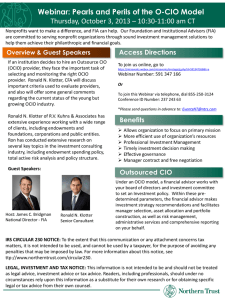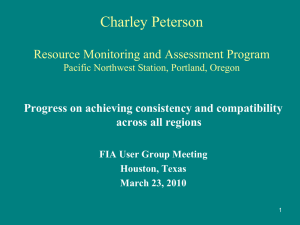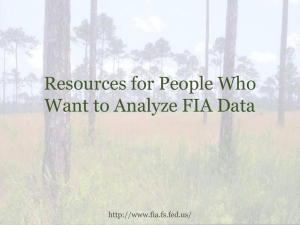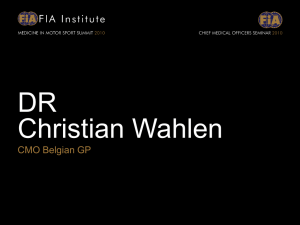Workshop Notes - Day 2
advertisement
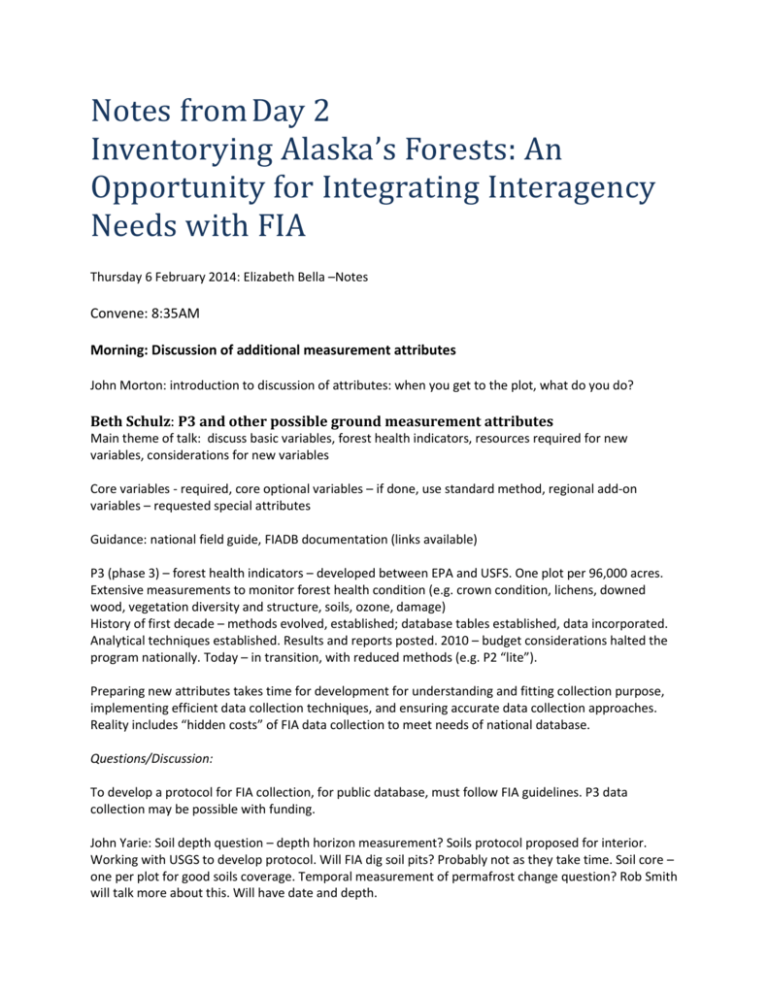
Notes from Day 2 Inventorying Alaska’s Forests: An Opportunity for Integrating Interagency Needs with FIA Thursday 6 February 2014: Elizabeth Bella –Notes Convene: 8:35AM Morning: Discussion of additional measurement attributes John Morton: introduction to discussion of attributes: when you get to the plot, what do you do? Beth Schulz: P3 and other possible ground measurement attributes Main theme of talk: discuss basic variables, forest health indicators, resources required for new variables, considerations for new variables Core variables - required, core optional variables – if done, use standard method, regional add-on variables – requested special attributes Guidance: national field guide, FIADB documentation (links available) P3 (phase 3) – forest health indicators – developed between EPA and USFS. One plot per 96,000 acres. Extensive measurements to monitor forest health condition (e.g. crown condition, lichens, downed wood, vegetation diversity and structure, soils, ozone, damage) History of first decade – methods evolved, established; database tables established, data incorporated. Analytical techniques established. Results and reports posted. 2010 – budget considerations halted the program nationally. Today – in transition, with reduced methods (e.g. P2 “lite”). Preparing new attributes takes time for development for understanding and fitting collection purpose, implementing efficient data collection techniques, and ensuring accurate data collection approaches. Reality includes “hidden costs” of FIA data collection to meet needs of national database. Questions/Discussion: To develop a protocol for FIA collection, for public database, must follow FIA guidelines. P3 data collection may be possible with funding. John Yarie: Soil depth question – depth horizon measurement? Soils protocol proposed for interior. Working with USGS to develop protocol. Will FIA dig soil pits? Probably not as they take time. Soil core – one per plot for good soils coverage. Temporal measurement of permafrost change question? Rob Smith will talk more about this. Will have date and depth. Integrating Interagency Needs FIA Meeting February 6, 2014 Any investigation of published soil survey of area? If available. Current plan – will P3 be on 1/3 or ¼ in current interior survey plan? Open to discussion, but no P3 are planned as this is a pilot study. There is value in P3. This summer will be a “Proof of concept” project, costs of implementation will be tracked, interior issues evaluated. Money may not be available again for many years, so efficiency in maximizing survey is important. P2 to P3 plot – how many extra hours? Crew members? Full suite of variable – minimum of four people. An hour to lay out, vegetation and down wood take time. Down wood may take less time in interior than southeast. Lichen protocol – will it include ground lichens? Rob will talk more on this. Interior moss and lichen layers in interior are critical for carbon accounting. NRCS soils protocols should be brought in – one pit per site. Key to what’s growing on it, and what changes will happen in vegetation. Current protocol is 4 inches into mineral, unless frozen. Overall - pilot study will require rationalization of best use of number of personnel, and what variables are possible to collect. Some protocols are Core Optional – some are not. Core Optional are defined. Robert J. Smith: Ground Layer Indicator From OSU, working on new attributes to measure ground layer of non-vascular vegetation including mosses and lichens. Carbon storage and functional importance in moss/lichen ground layers. Carbon storage is of prime importance due to development of sphagnum moss. Giant carbon sink. Baseline information to track changes over time. Climate change, arctic greening, measurement of nonforest areas also important. Nine functional groups (habitat/ecosystem) rather than species, e.g., forage lichens for caribou, N-fixing lichens, crust lichens, other lichens. Mosses – feathermosses for hydro functions, turf mosses to anchor soils, N-fixing feather mosses, sphagnum. Data collection considerations: non-destructive measurement by developing calibration curve (Depth (total live plus dead) appears to be greatest predictor); functional groups differences (biomass and C/N differences investigated), time efficiency (about one hour per plot), minimum sampling requirements (test sampled micro-quads/microplots within subplots along transects). OR/AK forest differences highlighted (higher moss biomass in upland/higher lichen biomass in alpine). 32 micro-quads per subplot is most efficient/appropriate number/size for ground cover measurements. Challenges – deep permafrost, deep peat. Questions/Discussion: Rob DeVelice: Ground penetrating radar – remote sensing options – have been used, but not effectively in permafrost. 2 – Day 2 Integrating Interagency Needs FIA Meeting February 6, 2014 Amy Miller: Functional groups – what is the mean value within habitat type? Range from zero to nine. Max measured was seven. AK – four, five, six or so normal in AK. Tina Boucher: Non-destructive measurements issues in interior AK – how to cope with lack of distinction in layers (brown vs. green, recognizable parts)? How did his crew deal with it? QA/QC checks possible this summer to check between-crew variation. Connie Hubbard: Logistical Considerations presentation on a day in the life of an FIA crew: Unique operations – work platform, distance between plots, remoteness. Safety and risk management complexity. Intensity of operations, 7 day a week operations. Complexity of operations/planning/training. Documentation and data management in field. Weight and space/size limitations with helicopter work (or float plane or boat) with field gear, fuel, safety gear, people. Generally 12 people is optimal. No P3 – 3 runs with helicopter, 2 hours to get crews out, 2 more to get crews back, walk to plot from landing site, one plot per crew per day. 15 day schedule. Limitations in hours per day, pilot safety hours, seasonal consideration – elevation (snow), latitude. Day to day equipment failures, weather/floods/aircraft availability changes. 15 minute break Discussion on Attributes: Introduction by Beth on pre-workshop survey results – FIA knowledge level, FIA data use; top five topics of interest; top ten attributes of interest. Diane Granfors: Tying data collection and attributes to objectives is important and should be considered. John Morton: Example of LTEMP, within FIA frame but specific to Refuge objectives. Gretchen Nicholas: East coast example – protocols paid for by large users for extra data collection. Variations exist that don’t have to do with current FIA data, can be measured concurrently and put in landowner’s database. Barb Schrader: Investment for field work – complete census necessary. We don’t have a diverse flora in AK, so well worth the time and expense as a good investment at least once, whether or not we continue to monitor. Dan Reese: Army system (Ft. Wainwright) – uses FIA system, fits large DOD land base. Adding cryptogam measurement would be valuable to add to their data. Lori Winton: add to Barb’s comment, and comparability – insects and disease not specifically discussed. Problem of definition of “forest health.” Risk map (mentioned yesterday) – comparable for all managers across AK. Beth: indicators already well developed (forest health protection) - damage was wellinstituted, but problems with repeatability. Reworked, taken a number of years. Damage is now Core in P2 (per tree). Complete species list (complete census) captures non-native species even if invasive species protocol is not implemented. Barb: make a point to hire taxonomically skilled team. Beth: AK tries to hire individuals with these skills. Tom Malone: Forest health considerations: does not take long to measure visual defects in trees. Eric S: Once a team learns protocol, becomes easier and second nature. Ray K: High botanical skills need (HV plot days). Good crew with botanical skills; annual (less people) still had good bot people; once P3 was eliminated there was less need for particular bot skills. 3 – Day 2 Integrating Interagency Needs FIA Meeting February 6, 2014 John M: 19 votes in favor of a complete census, supported by other comments, non-FIA people in room please raise hand if you are in favor of a complete census. Quite a few in hand raised hand (maybe 15 or so?) Lisa Saperstein: fire perspective – basic tree measurements inform fire models in interior. Post-fire monitoring also a benefit. Diane G: Do you have protocols for all attributes listed (top 10 on slide)? Beth: most of them, John may have some protocols for others. Simplify methods is tricky – no clear answer on what to pare down. Today, use resources wisely. Sydney (NRCS): soils perspective – different objectives. Some collaboration could be mutually beneficial with some effort put into soil measurements. Dan R: Army protocol definitions for moss layer, great manual. Soils – frozen soil does not equal permafrost. Sydney: avoid conflicting information within agencies. Robert Pattison: works with USGS – will come out and train FIA in their methods. Issue – work is done in early fall or have to use gas-powered auger. Specialized bit for O layer. Early season measurements are hard to make sense of. Ideal world is a whole soils and a whole plant survey (separate). Some overlap may occur. Beth: Extra variables cannot all be done perfectly – must be fit into what FIA’s core program is. Brochure – rapid assessment for soil –at least one sample to mineral soil in absence of frozen soil. Most efficient and most useful for what soil data can be. Eric: How important is it, if not done well or useful for other agencies? Beth: Not perfect, but depth with a date and current thaw is a point on the ground. More than what we have now. Robert P.: USGS – Below ground carbon sampling mostly done in areas with really deep soils. All done along the roads in Tanana, for example. Off-road sites are really valuable. Non-deep off-road samples are limited, would be useful. Data can be combined, can also use LIDAR biomass data, above and belowground carbon. Gretchen: What people want is something repeatable for soils protocols. Sydney: carbon is a primary goal for this group, NRCS has different objective, but goals can be compatible. Gretchen: protocol should dovetail (as already discussed). Eric S.: field actual conditions may surprise you. Beth: you never know what you will find – and all will add to the knowledge database. Eric Geisler: would like to incorporate NRCS protocol. Rob D: separate study like NRCS – network for soil modelling. Quick measurement attributes to predict broader characteristics Sydney: STATSGO exists for the state for general attributes, state-wide basis. Brad Scotton: What is main issue for collaboration between NRCS and FIA soil collection: On-site longer for NRCS? Sydney: Describes general approach (3rd/4th order soil interpretation) currently in use. Ken W./Beth S.: Legacy plot data exists, may be available (ask him). Some go back to 1950s. Lisa S: cryptic due to number codes. Ken W: working on this to provide a single unified data dictionary. 4 – Day 2 Integrating Interagency Needs FIA Meeting February 6, 2014 John M: summary – a lot of support for soils with NRCS, complete vegetation inventory, and discussion on insects and disease. Diane G: objective, for example climate change, what variables would be important? Complete vegetation inventory would be important. Wrap around some objectives. John DeLapp: Each agency has different objectives. Gretchen: we are primarily tasked with inventorying vegetation; other agencies like NRCS have a soil inventory objective. Carbon flux assessment example. Working with other agencies with different missions enhances FIA mission. Brad (USFWS): ecoregional objectives in USFWS for example – change in species composition over time, through different ecotypes on the ground. Species change on ecotonal boundaries. Change documentation over long term can clearly articulate species/assemblage change. Regional I&M objective – lends itself to FIA mission/group objective being discussed. Gretchen: Collaboration is possible. FIA job to assess/monitor vegetation (mostly with trees). FIA can connect the dots between agencies. Brad: cost estimates – stretch “tree” areas – as that is where species/assemblage change will take place. Discussion of aircraft cost and time application. John Y: post-disturbance years, key times to get a lot of data from these areas/temporal opportunities. Lisa S.: existing plots can be coded open and recon after. Gretchen: FIA has a fire effects protocol – burn intensity and carbon flux, on a grant-based basis. Jennifer (on phone): to Lisa – may be a DOI thing, may work on a Refuge etc. General discussion on ways to make it work. Are fire effects protocols on line? Beth: probably not, but she will look. Tara Barrett: Tried fire effects plots on Caribou Hills fire, worked out OK (despite giant CALCAN). Andy (on phone): NRI (National Resources Inventory) program (USDA, NRCS) and FIA (nonforest monitoring) – sampling frame may be opportunity for non-forest side, direct collaboration with NRI. Sydney: Familiar with 2007 AK NRI? AK is behind country as these are for non-fed lands. Done statewide but entirely focused on remote sensing information. Gretchen: Key in approaching nonforest inventory is to reduce duplicate efforts among agencies. Barb S.: National issues (terrestrial condition assessment) – we lack a way to systematically categorize nonforested lands. Important here in AK, but also nationally. Hans Anderson: NASA is a major partner with a separate set of objectives, although they are similar. Strong remote sensing element to their interest. Significant resources available for project support. Eric G.: Ecological site description protocol from NRCS is available. Andy Gray: Pilot tests combine efforts – downward slide may be underway although a publication is coming out on western efforts. NRI vegetation sampling AK to OR similarity? There is a lot of opportunity for melding sampling systems. GTR out of RMRS. John M.: Wildlife sampling (birds too) efforts – wildlife and insect area often involves traps, which require repeated site visits, which may limit thinking. Steve Matsuoko, USFWS, collaborator for possible pilot study with good sound recorders to leave for extended periods. Can be employed en masse to many plots in one day via helicopter, then leave on site until FIA crew comes. Good presence/absence data. 5 – Day 2 Integrating Interagency Needs FIA Meeting February 6, 2014 Eric/Ray: plot directions would also be known, can be shared with subsequent crews. John: deploy all kinds of data collection at once, a whole suite of data collectors to a site with only one visit, to be picked up by FIA crew. Eric: yes, and help speed them up with known coordinates to land and proceed to plot. Rob: Devices possibly dropped from air to plot? Connie: access issue, so dropping equipment may be beneficial/efficient. Can add things like bug traps, etc. Beth: John Lundquist transect example, Barrow to Homer, road-based survey. Laurie: early warning EDRR traps, mostly around ports, airports, towns. Beth: back to Diane’s comment on objectives – climate change is hot, but FIA is a long-standing, longterm program. We will have new objectives over time. Invasive species, for example; now climate change/carbon storage. Diane: modeling projections, would certain variables inform models? Peter Neitlich (on phone) (NPS): NPS has well-developed I&M program (mostly nonforested areas). Habitat trajectories over time, future forest distribution, types of forest/nonforest projections. Interests: habitat type conversion, pollution effects on habitat/range. Amy M. (NPS): SWAN (southwest network) – interest in forest expansion to west and southwest. LIDAR flights should capture shrub increases as well as tree. Full vegetation census would be favorable if possible. Sparse data points in AK, so anything we can get would be great. NPS has vegetation plots that can add into modeling efforts. Amanda Robertson: Integrated ecosystem model (IEM) – limited in terms of input. Any attributes would be excellent for IEM. Limitation is spare data points. Improvements would be increase in grid (more plots), and forest/tundra ecotone change monitoring, and change after disturbance (primary change driver in interior) for shift or change to different state. Beth: FIA moving towards All Lands inventory (pre-budget issues) for data collection on nonforested lands. Adjourn at 11:50AM. Lunch break Reconvene at 1:32PM. Hans Anderson. 2014 pilot/proof of concept project. Objectives –extend FIA footprint into interior AK, from Bonanza Creek/CPCRW experimental forests to Tanana Valley State Forest and Tetlin NWR. Increase/develop familiarity with interior AK logistics. Evaluate LIDAR/hyperspectral remote sensing information. Build relationships with cooperators (UAF, NASA (ABoVE, CMS), USFWS, AKDNR). UAF staff will access plots by ATV by road. Helicopter plots accessed and established by PNW lab in Fairbanks. Around 99 total plots. Pilot project in 2007 (Tara Barrett) – tested modified protocols around Anchorage. Robert P. Plot measurement description Current tree protocols with an additional microplot, to accommodate black spruce size. Current P2 understory vegetation and down material materials protocols (two 24’ transect per subplot = 8 per plot). 6 – Day 2 Integrating Interagency Needs FIA Meeting February 6, 2014 Ground layer sampling (composition and carbon content in micro-quads – Rob Smith and Sarah Jovan protocol, OSU and PNW-RMA Corvallis FSL). Soil sampling taken outside perimeter of main plot, current thaw depth (on all micro-quads) and below ground carbon (depth of litter/live moss, organic soil layers, mineral soil layers; samples for lab analysis for bulk density, C, etc.). Calculate below-ground carbon with measurements. 40” max depth limit with really thick organic layer. Will use power drill corer system (to not compress samples) – goes to 15”. Back to Hans: GPS position – requires good spatial coordinates to link with remote sensing imagery. Dual frequency, differentially corrected with US and Russian satellites for sub-meter error across boreal forest. Sampling grid: 1/4th intensity regular hexagonal grid (1 plot per 24,000 acres) – approximately 97 plots. Remote sensing by NASA-Goddard scientists (Bruce Cook, Ross Nelson, Doug Morton). G-LiHT instrument (Goddard LIDAR Hyperspectral Thermal system). LIDAR covers 3% of total area. Maps composition, structure, and condition of vegetation. Heat sensing equipment to quantify surface temperature and moisture stress. Important for interior drought stress trend tracking. Question for Hans – can we tell birch from aspen? Not exactly. Some literature exists that breaks out finer categories than softwood/hardwood. System specifics: VNIR spectral reflectance (e.g. RGB), surface temperature, tree height and crown size example. 3D vegetation structure, laser apparent reflectance. Slide shows specs for all measurement characteristics. All data are precisely georegistered via airborne GPS and inertial measurement unit. Flown on a Piper Cherokee aircraft. Example of scaling up from FIA field plot level, to biomass & carbon inventory, to enhanced inventory with tree variables, to fire and carbon stocks and losses mapping, to Bayesian joint probability mapping of carbon losses. Example of LIDAR strips on Kenai Peninsula with FIA plots, showed field measured trees with aerial photo and LIDAR image to segment out individual trees. Classification can determine hardwood versus conifer, white spruce versus birch. Interior pilot study will have better definition than Kenai example. Biomass estimate example with LANDFIRE model data. Discussed statistical estimators and products from pilot inventory. Questions/Discussion: Eric S.: Can you differentiate hardwood regeneration versus shrub? Reply: possibly, but haven’t tried it. Amanda: high confidence in pulling out alder stands, N-fixers will stand out in hyperspectral imagery. Rob D.: with number of bands, likely to be able to pull out individual species (best case scenario with this particular system). Comment: Defoliation action (birch/aspen) – we should be able to develop a signature of this type of defoliation. Brad: Curious about flying aspect – budget? Hours? Hans: $200,000. Hour estimate done but Hans would have to look it up. Ken W.: Would fit into a UAV. (UAF is one of the chosen schools to test these). Sydney: Who is doing image processing? Hans: NASA. John M.: Tetlin Refuge – leverage opportunity? Permitting? (Kristen D. from Tetlin was on the line earlier – Ken has talked to her, John will call her. She is on the line – she will be in touch with Ken). Robert P.: Products possible outside FIA data collection footprint, using outside data. Hans: NASA would be interested in flying over other existing plots in Tanana Valley area. Suzanne: Plot/LIDAR agreement issue? Stats to analyze together? Comparison to existing inventories (variable radius temporary plots exist for the area). Hans: Hopefully LIDAR will reduce the variance. Will Putnam: Is this process similar to a supervised classification? Hans: Yes, for a mapping type of approach, this would be possible – categorical classification, for example. In this case, we’re interested in a handful of variables, and a linear regression model. Each pixel in LIDAR strip will have species classification and structure values. 7 – Day 2 Integrating Interagency Needs FIA Meeting February 6, 2014 Ken: Illustrates need for precise knowledge of plot location. Survey grade was used, less expensive equipment suits purpose today. Question: Would a resource grade GPS work? 3 meter resolution with post-processing? Hans: mismatch in regression relationship would make this undesirable, blows up variance estimate. With so much effort into plot access, may as well bring high grade GPS. Ken: Spatial accuracy is not quite important with homogenous canopy, but important with heterogeneous cover to prevent mismatch. Question: In the event of a difficult fire season, what’s the plan? Well, can’t fly if it’s smoky. Mark Bergstrom (on phone) (USFWS Fairbanks): Same sampling intensity for LIDAR-area inventory area planned for remainder of Tanana unit? What are plans for 2015? Hans: Interval spacing corresponds to 1 in 4 hexagonal grid, matches LIDAR flight linear pattern. Could fly at a higher sampling intensity, with more strips – it’s a possibility, nothing set in stone. This particular intensity lined up with plots. Gretchen: Discussed earlier, national level FIA direction by Farm Bill – number 1 item that direction is. Has to be funded as well. FIA is working on it – congressional delegate connection, feds can express interest to national office. Congress has to supply the funding, or USFS has to supply funding. Request is 1.5 million$, less than prior. Should be met, but budgets are tight, although funding is difficult. This is mainly funded (2014) by NASA grant – coastal study put on hold this year, but congressional direction is for coastal survey. Question: if funded, is 2015 interior survey possible? Answer: Yes. Good as chance now as any. Ruth Gronquist: Where will next survey by? Does it depend on which agency comes up with funding? Gretchen: We don’t know yet – have to wait and see about funding. Hope is (via John M) to set up a small steering committee. Ray: periodic sampling for interior – go through watershed unit in next round if funded, so we could continue with finishing the Tanana Valley. Question would be what area is next with further funding. Lots of planning/staffing to gear up for a new area. John M.: Pushing back funding gives everyone more time to sort logistics out. Mark Rosenberg (on phone): congratulated Hans on talk. Glad LIDAR is being incorporated. Gretchen Nicholas: Next Steps and Wrap-Up Recognized John M. for organizing the event, and for his vision. Would like steering committee feedback on process, hopes and expectations: Scott G. (BLM): Interested in the process, glad to be able to participate and learn. Amanda R. (LCC-USFWS): Expectations low – knows how hard it is to go to different agencies seeking collaboration and funding. Often hears “let the LCCs do it.” (laughter). Low-budget climate encourages collaboration between agencies. Pleased with level of discussion and optimism, and resources already available. Grid-based approach is important for looking at agents of change, modeling exercise, etc. Gretchen: What do you see the role of the LCC as being? Amanda: We don’t have a lot of project funding, but are improving ability to facilitate connections between agencies and organizations to combine efforts, to increase efficiency. Can bring more applied focus to larger science initiatives. John DeLapp: Northwest boreal LCC spans huge area into Canada, with multiple representations even in this room of participants. John M. and Hans co-presentation to LCC board may be possible. Suzanne (other LCC) mentioned, commented on their process. 8 – Day 2 Integrating Interagency Needs FIA Meeting February 6, 2014 Amy Miller (NPS): Park centric approach to lands, but wants to continue to communicate to larger landscape and network. FIA makes sense to be involved. Strong interest in doing what NPS can to cooperate with FIA efforts. Optimistic and please with feedback and attendance. Amanda: post workshop survey possible John? Yes, has been discussed. Gretchen: Knowing/surveying next steps from participants/organizers is a good idea. Will Putnam: Encouraged by participation, learned more at meeting. Appreciated examples and feedback during presentations. Clients – landowners, native/tribal corporations, tribes – he’ll be able to take back perspective to meet their needs. Gretchen: Thanks to all the helpers (Doug Campbell, Matt Bowser, Elizabeth Bella) Beth Schulz (USFS-FIA): Pleased at the outcome and level of participation. Excellent to work with AK partners with perspective of extensive FIA and AK experience. Chris Maisch (State Forester): Difficult to get all agencies to work together across agencies boundaries, so this is positive. Important to move this ahead – strong base for needing a base for interior. Other agencies can build on base as more funding is available. Timing is not bad for getting more money into this program. Difficult, but no impossible. Biomass piece is important for sustainability questions. May be able to provide funding at some point. Steering committee is a good idea to put together a white paper to document process for continued support. John: maybe an advisory committee. John Morton (USFWS-KENWR): Not wedded to the FIA – but wedded to a landscape level inventory at the P2 level. Hope is to re-apply practices to southcentral as well. Next steps? Maybe a white paper and a small advisory group. With broader interest, everyone can review it. Gretchen: This is a multi-level initiative. Two pieces: national advocacy to congress and national offices, but we feds cannot contact congress but can answer questions. Also, agency level buyoff (I&M directors) for collaboration. White paper would be useful for agency heads. Need agency level agreement. Once base grid is established (agency support, communicated nationally; congressional approval and funding). Many ways to hang things off of the base grid. For the whole region, what are protocols that we already have that we can use, for example? What are some others? We discussed many of these, although they may not all be funded by FIA. A landowner may want to do an extra measurement – these are the steps that come afterwards. John’s idea of camera/gear collecting data drop off, for example. Brad: Collaborative partnerships are already starting. Keep ball rolling with buy-in and interest. Value in keeping momentum going. Gretchen: All of us will concentrate hard on getting everything done leading up to this summer and postprocessing. FIA role is delivery, which we have a history of doing on time and within budget. Beth: important to keep people engaged. Amanda/John D.: LCC role – would be great for John to come to next steering committee meeting (March). Lisa S.: Logistics of setting up interagency agreement? Time limitation? Money transfer? Gretchen: not sure, have some agreements set up. Joint venture agreements, cost-share agreements/ Connie: MOU, procurement agreements, between agencies/interagency to transfer money. Contracts, etc. Beth: travel etc. can/should be tracked. 9 – Day 2 Integrating Interagency Needs FIA Meeting February 6, 2014 Ken: Consider distributing a list of examples like MOU with KENWR. John M.: Not all land management agencies were able to participate – we could do something similar to this, maybe next year, after the pilot is done. Can time it with LCC steering committee meetings, in Fairbanks. Amy M.: Remind agencies that participation does not have to be monetary (housing, technical expertise, training, etc.). John M.: Will call Kristen D. in Tetlin, to see if they can leverage something out of the pilot, which would be a great example for next year. John Yarie (UAF): Gretchen asked for his university perspective: high potential for graduate student projects. Good soil descriptions for Bonanza Creek area, to inform study. Carol Jorgenson (Chugach NF Biologist): interest in drones. Poster session, meeting notes meeting distribution, contact lists, interest solicitation to other agencies. Tom: Heavy metals, mercury interest? Anyone else? John – Hylocomium study. Carol: land-landscape level fisher survey, model development (PNW USFS study). John considered bringing him up (maybe next year). Gretchen to Connie – your thoughts: Impressed by turnout and interest, engagement level. Understand limitations, and how each organization/agency can tie into the FIA grid is good. Interagency collaboration is important to meet needs in figuring out how to tie in information needs. Amanda: follow-up – don’t need all collaborators and cooperators at the table to start with, but that’s OK. Each organization can tailor interest to its objectives. Example of her past work as inventory grid and add-ons over time. Value added as add-on research projects may be individually funded by interest group/organization/agency, and project will grow. Gretchen: As we are building our empire here, the FIA Field of Dreams. Amy M.: You don’t have to do everything the first time through, just get the initial part established. John M.: Immediate short-term products: PDF of presentations, notes available. Would be good to include list of participants and agencies. Mark R. (on phone): Core attributes and regional options important. Mitigate by cost and time restraints. Good workshop. Barb Schrader: Summarize enthusiasm – plan for success. Daunting task, with national support, funding, etc. Opportunity in AK with less barriers, more connectivity between agencies/collaborators. John M.: outcome of white paper – highlight specific items underway. Gretchen: Obvious connections with NRCS. Rob D.: Impressed with lack of negative commentary – everyone is enthusiasm. Has heard John’s prior presentations on KENWR, interested in including Chugach National Forest in southcentral plot expansion, such as DNR barcoding opportunities. Linkage between north pacific and boreal LCC is important – knowing what is going on in adjacent landscapes. Gretchen – summary of next steps: We will put out a post-meeting survey. Two main outcomes: 1. Establish an advisory group that produces a white paper 2. Schedule a meeting next spring after survey data is processed. Grateful to organizers. Thanks to John M. and Beth. Applause and goodbye. 10 – Day 2 Integrating Interagency Needs FIA Meeting February 6, 2014 Conclude 3:50PM. 11 – Day 2
